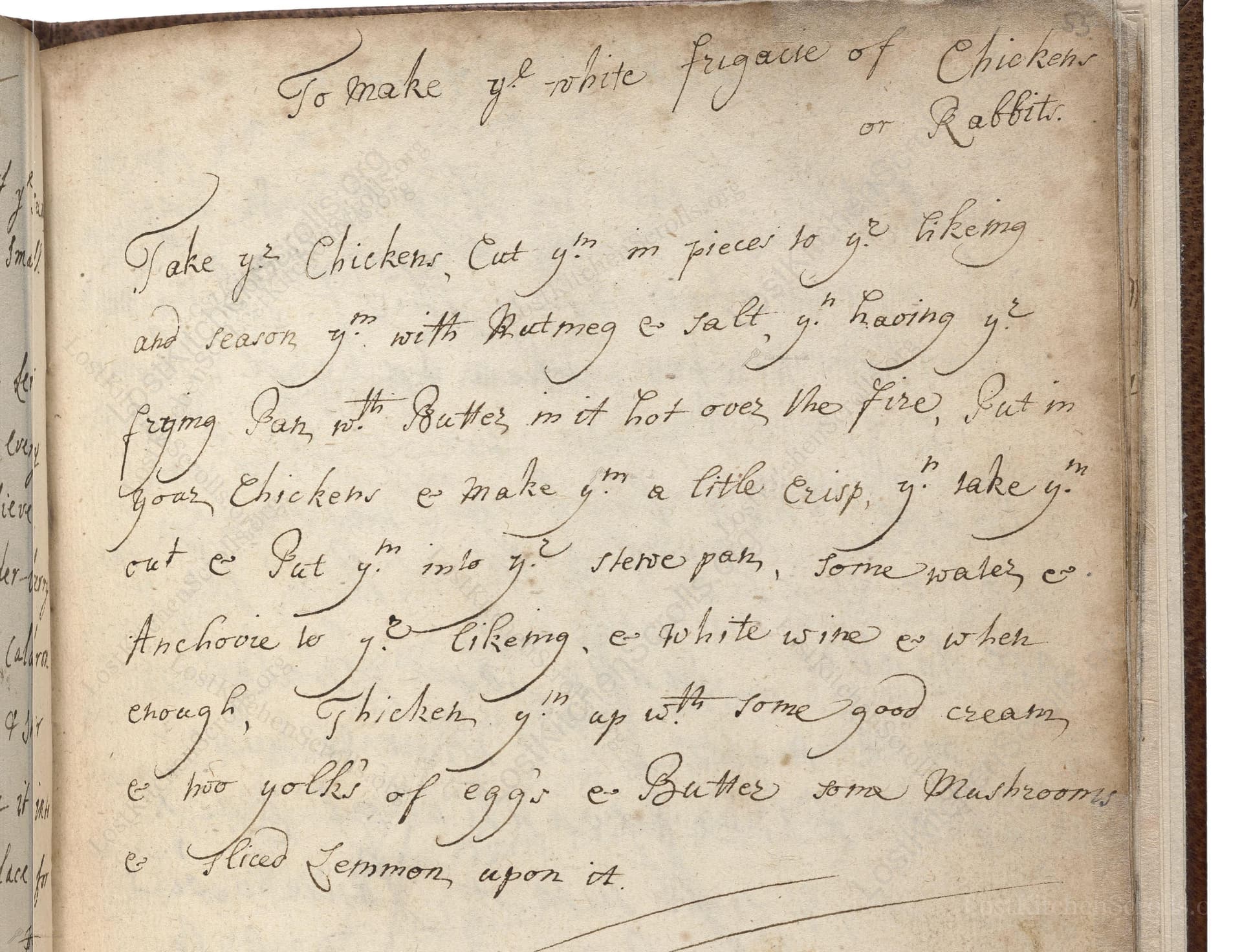To Make Ye White Frigasee Of Chickens Or Rabbits
From the treasured pages of Cookery book of Lettice Pudsey, Seisdon, Staffordshire
Written by Lettice Pudsey

To Make Ye White Frigasee Of Chickens Or Rabbits
"Take ye Chickens, Cut ym in pieces to ye likeing and season ym with Nutmeg & Salt, & haveing ye frying Pan, wth Butter in it hot over the fire, Put in your Chickens & make ym a litle Crisp, yn take ym out & Put ym into ye stewe pan, some water, & an Anchovie to ye likeing, & white wine & when enough, Thicken ym up wth some good cream, & two yolks of eggs & Butter some Mushrooms & Sliced Lemmon, upon it."
Note on the Original Text
The recipe uses archaic English, with abbreviations such as 'ym' for 'them', 'wth' for 'with', and 'ye' meaning 'the' (using the 'y' for the old English thorn letter). Spelling was highly variable, and punctuations sparse, making directions more conversational than prescriptive. Precise quantities are absent, as cooks were expected to rely on experience and judgment. The structure is sequential but flexible, focusing on method rather than strict measurements—a hallmark of early modern English recipes.

Title
Cookery book of Lettice Pudsey, Seisdon, Staffordshire (1675)
You can also click the book image above to peruse the original tome
Writer
Lettice Pudsey
Era
1675
Publisher
Unknown
Background
Step into the 17th-century kitchen with Lettice Pudsey's delightful collection of recipes, where flavors, creativity, and tradition mingle to create a feast fit for Restoration-era tables. Expect a medley of hearty English fare, intriguing ingredient combinations, and a pinch of culinary wisdom from a bygone age.
Kindly made available by
Folger Shakespeare Library
This elegant white fricassee recipe hails from the kitchen of Lettice Pudsey, circa 1675, a time when English country house cookery incorporated both native and fashionable continental influences. The dish exemplifies Restoration era tastes for subtly spiced white meats, enriched with cream and eggs—a mark of luxury. The inclusion of anchovy demonstrates the rising popularity of savory umami, blending the native and the novel at the English table. Cookbooks of this period often circulated in manuscript form among the gentry, treasured as personal household manuals. This recipe captures both practical know-how and a dash of 17th-century culinary flair.

Back in the 1670s, cooks worked over open hearths, using heavy wrought iron or copper pans and stew pots. Butter would have been clarified in a skillet set over coals, while a wooden spoon or paddle stirred the meat. The cream and egg thickener was likely whisked with a birch twig whisk, and the final mixture was carefully managed to avoid scrambling the eggs—no thermostatic stoves here! Mushrooms and lemons were sliced with a sharp kitchen knife, and serving was directly from the pan onto a trencher or platter.
Prep Time
20 mins
Cook Time
45 mins
Servings
4
We've done our best to adapt this historical recipe for modern kitchens, but some details may still need refinement. We warmly welcome feedback from fellow cooks and culinary historians — your insights support the entire community!
Ingredients
- 1 chicken (about 3 1/3 lbs) or 1 rabbit (about 2 2/3 lbs), cut into pieces
- 1/2 teaspoon grated nutmeg
- 1 teaspoon sea salt
- 3.5 tablespoons unsalted butter
- 7 fluid ounces water
- 1-2 anchovy fillets (or 1 tablespoon anchovy paste as substitute)
- 5 fluid ounces dry white wine
- 1/2 cup double (heavy) cream
- 2 egg yolks
- 2 tablespoons softened butter
- 3.5 ounces button mushrooms, sliced
- 1/2 of a fresh lemon, sliced thinly
Instructions
- Begin by taking a whole chicken (or rabbit) and cutting it into pieces as you prefer.
- Season the pieces generously with freshly grated nutmeg and salt.
- Heat 3.5 tablespoons of butter in a large frying pan over a medium-high flame until hot, then add the chicken pieces, frying until they develop a light, crisp exterior—about 5-7 minutes per side.
- Remove the chicken from the pan and set aside.
- In a stew pot, combine 7 fluid ounces of water, 1-2 anchovy fillets (chopped), and 5 fluid ounces of dry white wine.
- Place the browned chicken in the stew pot, cover, and simmer gently for 20-25 minutes until tender.
- In a separate bowl, whisk together 1/2 cup of double (heavy) cream, 2 egg yolks, and 2 tablespoons of softened butter.
- Temper this mixture with a little of the hot broth, then stir it into the stew to thicken.
- Add 3.5 ounces of button mushrooms (cleaned and sliced) and finish by laying thin slices of fresh lemon over the dish just before serving.
Estimated Calories
600 per serving
Cooking Estimates
You will need some time to prep and cut the chicken, gather the ingredients, fry the pieces, simmer, and finish the sauce. This recipe takes a bit over an hour from start to finish. Each serving is rich and filling.
As noted above, we have made our best effort to translate and adapt this historical recipe for modern kitchens, taking into account ingredients nowadays, cooking techniques, measurements, and so on. However, historical recipes often contain assumptions that require interpretation.
We'd love for anyone to help improve these adaptations. Community contributions are highly welcome. If you have suggestions, corrections, or cooking tips based on your experience with this recipe, please share them below.
Join the Discussion
Rate This Recipe
Dietary Preference
Main Ingredients
Occasions

Den Bockfisch In Einer Fleisch Suppen Zu Kochen
This recipe hails from a German manuscript cookbook compiled in 1696, a time whe...

Die Grieß Nudlen Zumachen
This recipe comes from a rather mysterious manuscript cookbook, penned anonymous...

Ein Boudain
This recipe comes from an anonymous German-language manuscript cookbook from 169...

Ein Gesaltzen Citroni
This recipe, dating from 1696, comes from an extensive anonymous German cookbook...
Browse our complete collection of time-honored recipes



